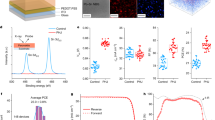
"Non-radiative recombination loss at the hole transport layer (HTL)/perovskite interface in the narrow-bandgap (NBG) subcell constrains the power-conversion efficiency (PCE) of all-perovskite tandem solar cells 1,2. Minimizing charge recombination at the buried interface of lead-tin (Pb-Sn) based NBG perovskite solar cells have proven particularly challenging, as conventional long-chain amine-based passivation strategies often induce carrier transport losses, thereby limiting both the fill factors (FF) and short-circuit current density (Jsc) 35. Here,"
"we developed a dipolar passivation strategy that reduces the trap density at the buried interface of mixed Pb-Sn perovskite while simultaneously enabling precise energy level alignment at the HTL/perovskite interface. This dipolar-induced passivation enhances ohmic contact, facilitating efficient hole injection into the HTL and repelling electrons from the HTL/Pb-Sn perovskite interface. This approach extends the carrier diffusion length to 6.2 m and enables a substantial enhancement in the PC"
Non-radiative recombination at the HTL/perovskite interface in narrow-bandgap Pb-Sn subcells limits all-perovskite tandem power-conversion efficiency. Conventional long-chain amine passivation reduces traps but introduces carrier transport losses that lower fill factor and short-circuit current. A dipolar passivation strategy reduces trap density at the buried Pb-Sn perovskite interface while enabling precise energy-level alignment at the HTL/perovskite boundary. The dipolar layer enhances ohmic contact, enables efficient hole injection into the HTL, and repels electrons from the interface. Carrier diffusion length extends to 6.2 m, producing substantial improvements in device metrics including FF and Jsc.
#perovskite-solar-cells #pb-sn-narrow-bandgap #dipolar-interface-passivation #htlperovskite-interface
Read at www.nature.com
Unable to calculate read time
Collection
[
|
...
]